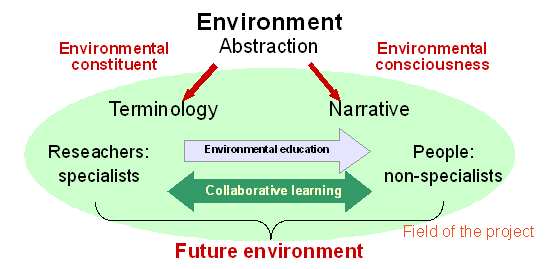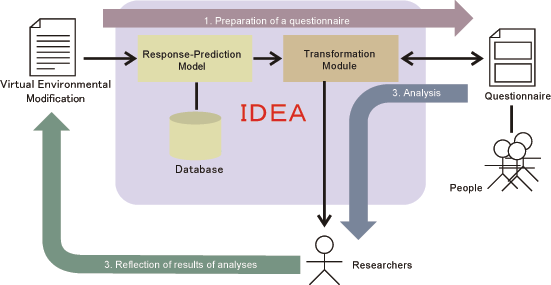 |
|
Project Background and Objectives
| Perception of the Environment |
|
People's perception of the environment affects their value judgments
of the environment as a basis to determine their attitudes toward it. We
define this value judgment system as the "environmental consciousness." People
use or modify their environment based on their environmental consciousness.
Each individual's environmental consciousness is influenced not only by
human-sociological factors, but also by the changes in environmental qualities.
The project will concentrate on exploring the changes in the environmental
consciousness induced by the modification of the environment. |
| Why do we focus on the environmental
elements? |
|
In order to understand the present situation
of the environment and to predict its future it is necessary to grasp the
environmental quality as quantitative evaluation of environmental elements.
Clarifying the relationship between the environmental quality and people's
environmental consciousness is an important task for wise-use and conservation
of natural environment. When an environment is considerably modified, an
environmental assessment with public involvement is necessary. To make
the public involvement substantive, people must be informed of the present
situation of the environment concerned and on the predicted environmental
impacts. Such information must be presented in a way that people can easily
understand to reconsider their lifestyle. |
| Specialists and Non-Specialists |
|
Environmental specialists have conventionally done the environmental
education using the translation from the scientific terminology to ordinary
language. Is such one-way connection between people's and specialists appropriate
for people to create the future environment and their lives? Specialists
should not only concern with how to convey their scientific information
to the people but also with how people would understand the information
and express their desired future environment in non-scientific expressions.
On the other hand, non-specialist people must self-consciously evaluate
the environment by exchanging the information with specialists. However,
there has been no attempts to develop a framework that supports the active
information exchange between specialists and non-specialists.
In this project, the framework will be considered from the conceptual
point of view to develop a methodology for identifying a set of environmental
elements, which affect the people's environmental consciousness. The schematic
diagram of the relationship between people and specialist focused in this
project is shown in Figure 1.
 |
Figure 1.
Specialists abstract environments with terminology., while people percept
and express environments using everyday expressions. In the conventional
environmental education, the flow of information about the environment
was only from specialist to the people in one-way translation of
academic information into plain words. However, the collaborative
relationship between them with bilateral exchange of information
is necessary to create the people's desired future environment. In
this project, a methodology for the bilateral information exchange
will be developed. |
|
| Framework of the Project |
|
In the project, the relationship between changing value judgments and
environmental quality will be analyzed in a forest-lake ecosystem. The
methodology to be developed requires several functions: (1) quantitative
prediction of changes in environmental elements caused by virtual environmental
modifications, such as logging and dairy farming, (2) informing appropriately
the environmental changes to people and (3) analysis of the relationship
between changes in the people's value judgment and in the environmental
elements (Figure 2). IDEA will be developed as a main tool that provides
all the functions above.
Figure 2.
Response-prediction model predicts the changes in the environmental
elements when a virtual environmental modification is applied to
the environment concerned. Transformation module translates the predicted
changes into plain words that are used in the questionnaire to people.
Data derived from the questionnaire survey are analyzed, and some
of the results will be fed back to the new set of questionnaire.
From the relation between changes in the environmental elements and
changes in the people's evaluation on the environment, a set of environmental
elements affecting the people's environmental valuation will be identified.
Repeated questionnaire survey with increasingly focused questions
will untangle the complexities of the interactions among environmental
elements and the formation of people's consciousness. |
 |
Using a response-prediction model in IDEA, changes in environmental elements
based on the virtual modifications in watershed (Figure 3) are quantitatively
estimated. Predicted environmental changes are transformed into plain words
by the transformation module. Changes in the peoples' environmental consciousness
are detected by questionnaire surveys. Survey data are analyzed with IDEA
and to be reflected in new questionnaires. Through bilateral information
exchanges between people and specialists, substantial knowledge about the
relationship between environmental consciousness and environmental elements
will be gained from IDEA.
IDEA is targeted to be used in the environmental policy-making. In
the procedure for the planning and implementation of the environmental
measure, the methods developed in this project will provide the bases to
establish the mutual agreement for the measure concerned, keeping the sustainability
and possibility for future generations. |
|
Copyright © 2005 Research Institute for Humanity and Nature. All rights reserved.
|
|

